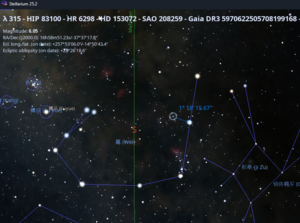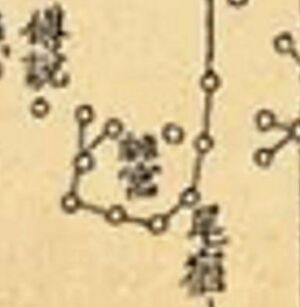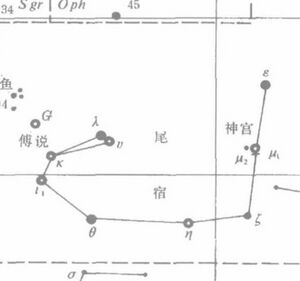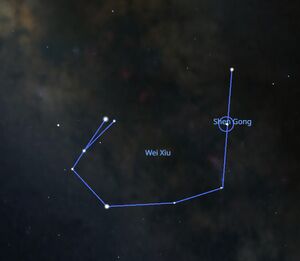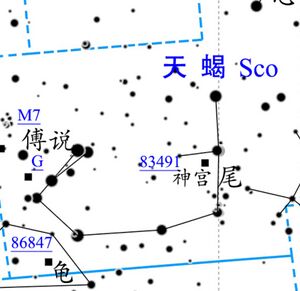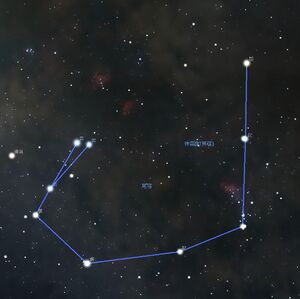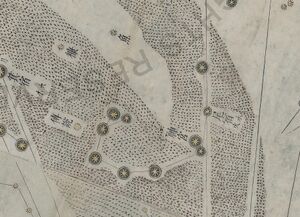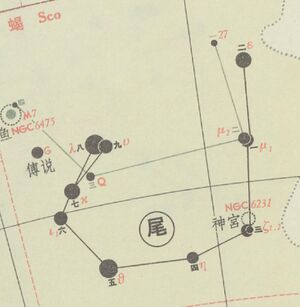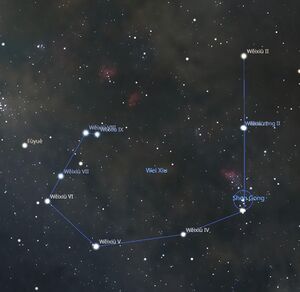Shengong: Difference between revisions
No edit summary |
No edit summary |
||
| (14 intermediate revisions by 2 users not shown) | |||
| Line 1: | Line 1: | ||
{{DISPLAYTITLE: Shengong (神宫)}} |
{{DISPLAYTITLE: Shengong (神宫)}} |
||
[[File:Wei+Shengong Screenshot 2025-10-16 085109.png|thumb|Shengong 1° east of μ<sub>1,2</sub> Sco (WGSN in Stellarium). ]] |
[[File:Wei+Shengong Screenshot 2025-10-16 085109.png|thumb|Shengong 1° east of μ<sub>1,2</sub> Sco (WGSN in Stellarium). ]] |
||
Shengong (神宫, Divine Palace) is a subsidiary asterism attached to the lodge [[Wei]], located to the left of its determinative star and consisting of only a single star. |
Shengong (神宫, Divine Palace) is a subsidiary asterism attached to the lodge [[Wei]], located to the left of its determinative star and consisting of only one star (a single star-asterism). |
||
Shengong is also a modern star name, adopted by the IAU in 2025 for the star HIP 83100, an unresolved binary of 6.05 mag. |
|||
== Concordance, Etymology, History == |
== Concordance, Etymology, History == |
||
[[File:Wei Stellarium WGSN2025.gif|thumb|Chinese "Wei" (Tail)-constellation with a slightly emphasized Milky Way, simulated with Stellarium 2025. The two amorphous regions show that there are many faint stars embedded in bright clouds of the Milky Way. It suggests that ancient astronomers considered these asterisms (or "stars") as "patchy" and not as accurate dots.]] |
[[File:Wei Stellarium WGSN2025.gif|thumb|Chinese "Wei" (Tail)-constellation with a slightly emphasized Milky Way, simulated with Stellarium 2025. The two amorphous regions show that there are many faint stars embedded in bright clouds of the Milky Way. It suggests that ancient astronomers considered these asterisms (or "stars") as "patchy" and not as accurate dots. (Susanne M Hoffmann)]] |
||
''Shengong'' represents the intimate chamber shared by the emperor and his consorts; for a detailed discussion of its symbolism and origin, see the entry [[Wei]]. |
''Shengong'' represents the intimate chamber shared by the emperor and his consorts; for a detailed discussion of its symbolism and origin, see the entry [[Wei]]. |
||
| ⚫ | |||
''Shengong'' (the “Divine Palace”) first appeared in the early eighth century ''Kaiyuan zhanjing'' (''Divination Canon of Kaiyuan Reign, KYZJ'', compiles between 712–718 CE), and was identified with μ² Scorpii. Because μ¹ and μ² are separated by only 0.1°, it is conceivable that some observers could not distinguish between the two and regarded them as a single star. In that case, ''Shengong'' should have been observed as another star. |
|||
Another possible cause of misidentification lies in the star maps themselves. Many historical star maps—such as those in ''Xinyixiangfayao star map''—depict the distance between ''Shengong'' and μ² as much larger than it actually is. For whatever reason, the observers of ''Jingyou Star Catalogue'' (compiled in 1034 CE by Yang Weide) identified ''Shengong'' as a different star: the coordinates they obtained with the armillary sphere were about one degree away from the meridian crossing μ¹, far exceeding the real separation of 0.1°. In the star map shown below (second row, second column), the black square marks the coordinate observed in 1034. |
|||
The asterism is mentioned only in some of the historical sources: two maps and a star catalog. |
|||
| ⚫ | |||
The coordinates given in the star catalog are: " ... " |
|||
Susanne M Hoffmann points out:<blockquote>Look at the simulation in Stellarium. Both stars in question (HIP 83100 and HIP 83491), as well as HIP 83499 (6.51 mag) and several other faint stars, are embedded in a patch of Milky Way clouds. Against the bright background of the Milky Way, it is rather difficult to distinguish the faint dots. |
|||
| ⚫ | |||
In a recent paper, I propose that regarding Ptolemy’s ''Almagest,'' his term “nebulous star” refers to such scenarios (Hoffmann 2025). I demonstrated (based on coordinates) that all of his “nebulous stars” are in fact small groups of two or more faint stars embedded in Milky Way clouds. They are not necessarily star clusters in the modern sense but regions in the sky where, under poor observing conditions (such as the humid climate of Alexandria on the Egyptian coast), the human eye perceives only something “nebulous”—a hazy patch. For example, Ptolemy gives three coordinates in ''[[Coma Berenices]]'' and instructs the globe-maker to “draw an ivy leaf” ([[Phyllon Kissinou]]) anchored at these three points. Likewise, he gives one coordinate and says “draw the head of [[Orion]] around it,” implying that the “head” was conceived as an extended area rather than a single point. |
|||
| ⚫ | |||
According to the ''Kaiyuan zhanjing'' (''Divination Canon of Kaiyuan Reign, KYZJ'', compiles between 712–718 CE), ''Shengong'' corresponds to μ² Scorpii. However, in later periods some astronomers identified it with other stars. For instance, the ''Jingyou Star Catalogue'' (compiled in 1034 CE by Yang Weide) placed ''Shengong'' roughly one degree away from the determinative star, which may correspond to HIP 83000 (barely visible after atmospheric extinction) or the slightly brighter HIP 83491. In the Qing dynasty, astronomers further associated it with the open cluster NGC 6231. |
|||
…I think you can safely choose any one of the stars around 6th magnitude without fear of criticism.</blockquote>This is an excellent point: for observers of that period, who were not necessarily pursuing strict precision, ''Shengong'' might have referred to any of the faint stars in that region—or even to the entire patch itself. |
|||
However, Boshun Yang and his Chinese colleague have identified another pattern: within this area, the coordinates of stars recorded in the ''Jingyou Star Catalogue'' show a common systematic error among the observed objects (indicated by the red arrow in the star map of the second row, second column). Based on this systematic offset, HIP 83100 appears to be the more probable target of measurement. |
|||
Therefore, taking all clues into account, we finally identify HIP 83100 as the ''Shengong'' during the ''Jingyou'' period, although HIP 83491 may have been regarded as ''Shengong'' in other periods. |
|||
{| class="wikitable" |
{| class="wikitable" |
||
|+ |
|+ |
||
| Line 21: | Line 30: | ||
Based on catalogue in 18th century |
Based on catalogue in 18th century |
||
!Pan Nai<ref name=":0">Pan Nai潘鼐. ''Zhongguo Hengxing Guance shi''中国恒星观测史[M]. Shanghai: Xuelin Pree. 1989. p226.</ref> |
!Pan Nai<ref name=":0">Pan Nai潘鼐. ''Zhongguo Hengxing Guance shi''中国恒星观测史[M]. Shanghai: Xuelin Pree. 1989. p226.</ref> |
||
based on |
based on Huangyou Star Catalogue (1052) |
||
!Pan Nai<ref>Pan Nai潘鼐. ''Zhongguo Hengxing Guance shi''中国恒星观测史[M]. Shanghai: Xuelin Pree. 2009. p443.</ref> |
!Pan Nai<ref>Pan Nai潘鼐. ''Zhongguo Hengxing Guance shi''中国恒星观测史[M]. Shanghai: Xuelin Pree. 2009. p443.</ref> |
||
based on catalogues in Yuan dynasty |
based on catalogues in Yuan dynasty |
||
!Boshun Yang<ref name=":1">B.-S. Yang杨伯顺, ''Zhongguo Chuantong Hengxing Guance Jingdu ji Xingguan Yanbian Yanjiu'' 中国传统恒星观测精度及星官演变研究 (A Research on the Accuracy of Chinese Traditional Star Observation and the Evolution of Constellations), PhD thesis, (Hefei: University of Science and Technology of China, 2023). 261.</ref> |
!Boshun Yang<ref name=":1">B.-S. Yang杨伯顺, ''Zhongguo Chuantong Hengxing Guance Jingdu ji Xingguan Yanbian Yanjiu'' 中国传统恒星观测精度及星官演变研究 (A Research on the Accuracy of Chinese Traditional Star Observation and the Evolution of Constellations), PhD thesis, (Hefei: University of Science and Technology of China, 2023). 261.</ref> |
||
based on Jingyou Star Catalogue (1034) |
|||
|- |
|- |
||
| Shengong |
| Shengong |
||
| Line 31: | Line 40: | ||
| mu<sup>2</sup> Sco |
| mu<sup>2</sup> Sco |
||
| mu<sup>2</sup> Sco |
| mu<sup>2</sup> Sco |
||
| HIP |
| HIP 83100 |
||
|} |
|} |
||
| Line 46: | Line 55: | ||
|- |
|- |
||
| |
| |
||
|[[File:Wei and Shengong observed in 1034 Reconstructed by Yang Boshun(2023).jpg|thumb|Wei and Shengong observed in 1034 Reconstructed by Yang Boshun |
|[[File:Wei and Shengong observed in 1034 Reconstructed by Yang Boshun(2023).jpg|thumb|Wei and Shengong observed in 1034 Reconstructed by Yang Boshun]] |
||
|[[File:Wei and Shengong observed in 1034 demonstrated in Stellarium.jpg|thumb|Wei and Shengong observed in 1034 demonstrated in Stellarium]] |
|[[File:Wei and Shengong observed in 1034 demonstrated in Stellarium.jpg|thumb|Wei and Shengong observed in 1034 demonstrated in Stellarium]] |
||
|- |
|- |
||
| Line 56: | Line 65: | ||
== Star Name Discussion (IAU) == |
== Star Name Discussion (IAU) == |
||
In 2025, the name of the historical constellation "Shengong" was suggested to be used for one of the stars in this constellation. As |
In 2025, the name of the historical constellation "Shengong" was suggested to be used for one of the stars in this constellation. As mu<sup>2</sup> Sco was named as [[Pipirima]] already, it is proper to apply Shengong to HIP 83100, a 6.05 mag star in [[Scorpius]]. |
||
Decision: . |
Decision: The name was adopted on 16 October 2025. |
||
==References == |
==References == |
||
| Line 65: | Line 74: | ||
[[Category:Asterism ]] |
[[Category:Asterism ]] |
||
[[Category:Single star-asterism ]] |
|||
[[Category:IAU-Star Name]] |
|||
[[Category:Constellation ]] |
[[Category:Constellation ]] |
||
[[Category:Eurasia]] |
[[Category:Eurasia]] |
||
[[Category:East Asian]] |
[[Category:East Asian]] |
||
[[Category:Chinese ]] |
[[Category:Chinese ]] |
||
[[Category:Sco]] |
|||
Latest revision as of 07:53, 17 October 2025
Shengong (神宫, Divine Palace) is a subsidiary asterism attached to the lodge Wěi (尾), located to the left of its determinative star and consisting of only one star (a single star-asterism).
Shengong is also a modern star name, adopted by the IAU in 2025 for the star HIP 83100, an unresolved binary of 6.05 mag.
Concordance, Etymology, History
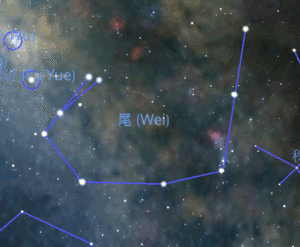
Shengong represents the intimate chamber shared by the emperor and his consorts; for a detailed discussion of its symbolism and origin, see the entry Wěi (尾).
Identification of stars
Shengong (the “Divine Palace”) first appeared in the early eighth century Kaiyuan zhanjing (Divination Canon of Kaiyuan Reign, KYZJ, compiles between 712–718 CE), and was identified with μ² Scorpii. Because μ¹ and μ² are separated by only 0.1°, it is conceivable that some observers could not distinguish between the two and regarded them as a single star. In that case, Shengong should have been observed as another star.
Another possible cause of misidentification lies in the star maps themselves. Many historical star maps—such as those in Xinyixiangfayao star map—depict the distance between Shengong and μ² as much larger than it actually is. For whatever reason, the observers of Jingyou Star Catalogue (compiled in 1034 CE by Yang Weide) identified Shengong as a different star: the coordinates they obtained with the armillary sphere were about one degree away from the meridian crossing μ¹, far exceeding the real separation of 0.1°. In the star map shown below (second row, second column), the black square marks the coordinate observed in 1034.
The position of Shengong would thus correspond either to HIP 83100, which has a visual magnitude of 6.05, or to HIP 83491, which lies slightly farther east but is somewhat brighter (V = 5.9 mag).
Susanne M Hoffmann points out:
Look at the simulation in Stellarium. Both stars in question (HIP 83100 and HIP 83491), as well as HIP 83499 (6.51 mag) and several other faint stars, are embedded in a patch of Milky Way clouds. Against the bright background of the Milky Way, it is rather difficult to distinguish the faint dots.
In a recent paper, I propose that regarding Ptolemy’s Almagest, his term “nebulous star” refers to such scenarios (Hoffmann 2025). I demonstrated (based on coordinates) that all of his “nebulous stars” are in fact small groups of two or more faint stars embedded in Milky Way clouds. They are not necessarily star clusters in the modern sense but regions in the sky where, under poor observing conditions (such as the humid climate of Alexandria on the Egyptian coast), the human eye perceives only something “nebulous”—a hazy patch. For example, Ptolemy gives three coordinates in Coma Berenices (πλόκαμος) and instructs the globe-maker to “draw an ivy leaf” (Phyllon Kissinou (φύλλοv κισσίνου)) anchored at these three points. Likewise, he gives one coordinate and says “draw the head of Orion around it,” implying that the “head” was conceived as an extended area rather than a single point.
…I think you can safely choose any one of the stars around 6th magnitude without fear of criticism.
This is an excellent point: for observers of that period, who were not necessarily pursuing strict precision, Shengong might have referred to any of the faint stars in that region—or even to the entire patch itself.
However, Boshun Yang and his Chinese colleague have identified another pattern: within this area, the coordinates of stars recorded in the Jingyou Star Catalogue show a common systematic error among the observed objects (indicated by the red arrow in the star map of the second row, second column). Based on this systematic offset, HIP 83100 appears to be the more probable target of measurement.
Therefore, taking all clues into account, we finally identify HIP 83100 as the Shengong during the Jingyou period, although HIP 83491 may have been regarded as Shengong in other periods.
| Star Names or Orders(Traditional/Qing) | Yi Shitong[1]
Based on catalogue in 18th century |
Pan Nai[2]
based on Huangyou Star Catalogue (1052) |
Pan Nai[3]
based on catalogues in Yuan dynasty |
Boshun Yang[4]
based on Jingyou Star Catalogue (1034) |
|---|---|---|---|---|
| Shengong | NGC 6231 | mu2 Sco | mu2 Sco | HIP 83100 |
Maps (Gallery)
| historical map | modern identification | same in Stellarium |
|---|---|---|
Star Name Discussion (IAU)
In 2025, the name of the historical constellation "Shengong" was suggested to be used for one of the stars in this constellation. As mu2 Sco was named as Pipirima already, it is proper to apply Shengong to HIP 83100, a 6.05 mag star in Scorpius.
Decision: The name was adopted on 16 October 2025.
References
- ↑ Yi Shitong伊世同. Zhongxi Duizhao Hengxing Tubiao中西对照恒星图表1950. Beijing: Science Press.1981: 56.
- ↑ Pan Nai潘鼐. Zhongguo Hengxing Guance shi中国恒星观测史[M]. Shanghai: Xuelin Pree. 1989. p226.
- ↑ Pan Nai潘鼐. Zhongguo Hengxing Guance shi中国恒星观测史[M]. Shanghai: Xuelin Pree. 2009. p443.
- ↑ B.-S. Yang杨伯顺, Zhongguo Chuantong Hengxing Guance Jingdu ji Xingguan Yanbian Yanjiu 中国传统恒星观测精度及星官演变研究 (A Research on the Accuracy of Chinese Traditional Star Observation and the Evolution of Constellations), PhD thesis, (Hefei: University of Science and Technology of China, 2023). 261.
